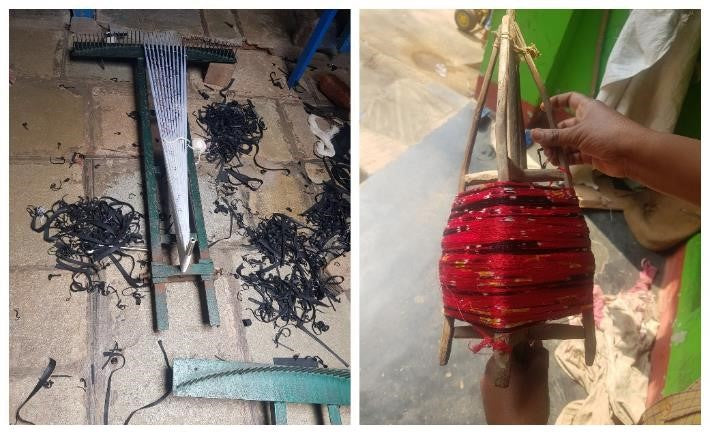Jharkhand
There is a hushed silence in a small room where two women, oblivious to my presence, have their eyes focused only on what they are doing. Two plywood planks serve as makeshift easels for the fabric on which they are painstakingly painting intricate designs. On the larger of the two fabrics, an elaborate outline is completed, whereas on the other, the outline is slowly taking shape. Little specks of green colour are being dabbed carefully on the larger fabric. Everything is being done by hand; there are no whirring of machines and no automatic processes. Just the two artisans and their simple implements: two watercolour-style paintbrushes and two small bowls of paint.

Odisha
“What a remarkable loom this is,” I said, mesmerized. “I have never seen something like this before.” It was indeed amazing to see the artisan, an elderly gentleman possibly in his early sixties, patiently working on the loom which itself seemed ancient. “How much time does it take to weave a saree if all preparations have been done?” I asked the local representative who was accompanying me. “It takes 7-8 days to weave one saree once the background work has been completed,” he responded.

Pochampally
I can hear a rhythmic wooden sound coming from a corner of the large, hall-like room. All around me are traditional looms, dyed handloom fibre hanging to dry, and leftover fabrics on the floor. I move around the room, trying to identify the source of the sound. I finally know. A lady’s hand is working deftly on a wooden loom, the source of the sound. I go around to get a better view – I am greeted with a wonderful smile by a lady who is at least 60 years old. In a couple of seconds, her eyes focus back on the loom.

Welcome to a world of handloom textiles and fashion which is far removed from electronic equipment and machines, which shuns chemicals and hazardous material, and where the artisans’ skills leave you in awe. This is the world of slow fashion where the weavers of sarees are in no hurry to churn out one design after another. This is a place where heritage and tradition matter much more than copying latest international fashion styles. The weavers’ world embodies a philosophy which believes in protecting the environment and our planet.
When I visited weavers and their families in remote villages of India, I was humbled to see their spartan lifestyle and simple way of living. This has a strong influence on their work, which is based on the philosophy of zero wastage and using leftover fibres and fabrics. The weavers protect the environment by using natural fibres, dyes and colours, and employing eco-friendly techniques for softening and washing fabric. I had always heard of ‘slow fashion’, but these visits made me see it for myself.

Fast fashion, on the other hand, makes rampant use of synthetic fabrics, chemical dyes and ecologically damaging processes in the entire lifecycle of manufacturing a garment. Fast fashion copies latest styles from international runways to produce cheaply priced collections for mass consumption. The problem does not end there. Fast fashion is synonymous with ‘single-use fashion’ – many garments are worn only once before being discarded. This leads to enormous environmental costs since a majority of these clothes end up in landfills or are incinerated.
Slow fashion needs to become a mainstay of India’s fashion consciousness
To me, slow fashion is not a trend or a fad; it is a change which has been gaining ground globally to improve the fashion industry’s environmental footprint. It involves a conscious effort of being mindful of the environmental and socioeconomic impacts of what we are wearing. Slow fashion represents a “buy less, wear more” philosophy. By purchasing high-quality garments which are created using sustainable materials and processes, each one of us can become a participant in the slow fashion movement.
Traditional handloom sarees, which have been an integral part of Indian culture since time immemorial, epitomize the slow fashion movement. These exquisite sarees occupy pride of place in owners’ wardrobes, to be treasured and worn year after year. Quite often, handloom sarees are passed down as heirlooms to the next generation. By promoting handlooms, we are not only preserving India’s cultural heritage but also proving a steady source of income to weavers and their families.
The last few years have seen the concept of sustainability and slow fashion gradually weaving its way into Indian fashion choices. Sustainable fabrics are being produced in many regions of the country, and close attention is being paid to the environmental impact of a garment’s production life cycle. This needs to become a mainstay of India’s fashion consciousness.
Slow fashion is a time-consuming and painstaking process. It also entails a reasonably high capital commitment. This renders slow fashion more expensive than its fast counterpart. However, consumers’ mindsets need to change from a ‘wear-once-and-throw’ approach to investing in fashion which is sustainable and can be worn repeatedly. This will set an example for future generations and imbibe the true essence of slow fashion.




